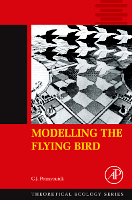Welcome
Welcome to the website for Pennycuick, C: Modelling the Flying Bird.
Modelling the Flying Bird
About this companion site
Welcome to the support website for Pennycuick: Modelling the Flying Bird.
About this book
This book outlines the principles of flight, of birds in particular. It describes a way of simplifying the mechanics of flight into a practical computer program, which will predict in some detail what any bird, real or hypothetical, can and cannot do. The Flight program, which is available for download from this website, generates performance curves for flapping and gliding flight, and simulations of long-distance migration that account successfully for the consumption of muscles and other tissues during migratory flights. The program is effectively a working model of a flying bird (or bat or pterosaur) and is the skeleton around which the book is built. The book provides a wider background and then explains how Flight works and shows how to set up and test hypotheses generated by the program. The book and the program are based on adapting the conventional (and well-tested) thinking of aeronautical engineers to the biological problems of bird flight. Their primary aim is to convince biologists that this is the appropriate way to handle problems that involve flight, to make the engineering background accessible to biologists, and to provide a tool kit in the shape of the Flight program, which they can use to solve practical problems involving bird flight and migration. In addition, the book will be readily accessible to engineers who want to know how birds work, and should be of interest to the ever-growing community working on flapping "micro air vehicles" (MAVs). The program can be used to predict the flight performance and capabilities of reconstructed fossil birds and pterosaurs, flying in ancient atmospheres that differ from present conditions, and also, of course, to predict and account for the results of experiments and observations on living birds and bats.
Key features
- An up to date work by the world's leading expert on bird flight
- Examines the biology and biomechanics of bird flight with added reference to the flight of bats and pterosaurs
- Uses proven aeronautical principles to help solve biological issues in understanding and predicting the flight capabilities of birds and other vertebrates
- Provides insights into the evolution of flight and the likely capabilities of extinct birds and reptiles
- Gives a detailed explanation of the science behind, and use of, the author's predictive bird flight simulation program - Flight - which is available on this website
- Presents often difficult concepts in easily understood language
Flight 1.25 Installation package
The program calculates power curves for flapping flight and glide polars, and also does numerical simulations of long distance migration. Databases of bird measurements are included, and there is an extensive online manual, which now covers the analysis of GPS tracks. A kit of Excel is files (GPS Kit.zip) is provided for this, and can be found after installation in the "Extras" sub-folder, within the "Program Files| Flight" folder.
- Flight 125 (17670KB Zip File)
- Flight 1.25 ReadMe (5KB Text File)
Flight program output for allometric plots
Power curves and glide polars in the form of Excel output from the Flight program, for 220 species from the "Wings" database (included with the program). These files are the source for the allometric plots in Chapter 13 of the book.
- Flight prog output for allometric plots (1946KB Zip File)
Liquid crystal stroboscope
An instrument for measuring wingbeat frequencies of steadily-flapping birds. Technical level: hobby electronics.
- Liquid Crystal Stroboscope (294KB Zip File)
Illustrations from the book
- Chapter 2 Air kinematic viscosity (9609KB Zip File)
- Chapter 1 Wing measurements, definitions and procedures (9546KB Zip File)
- Chapter 4 Vortex principles applied to aircraft and bird wakes (7960KB Zip File)
- Chapter 5 Mechanics of bird wings, beams, skeletons, feathers, muscles (11874KB Zip File)
- Chapter 3 Power requirements for horizontal flapping flight (19279KB Zip File)
- Chapter 6 Mechanics of bat and pterosaur wings, stereo photos and contour maps (11437KB Zip File)
- Chapter 7 Muscle mechanics and performance, supported by respiratory systems (23364KB Zip File)
- Chapter 8 Long-distance migration principles and Flight numerical simulations (13074KB Zip File)
- Chapter 9 Intermittent flight, control, manoeuvring (8742KB Zip File)
- Chapter 10 Glide polars, thermal soaring, albatross soaring (11015KB Zip File)
- Chapter 11 Knowing which way is up - Sensory information in flight (11264KB Zip File)
- Chapter 12 Foot and wing swimming, flight with reduced wings (4159KB Zip File)
- Chapter 13 Allometric graphs of quantities calculated by the Flight program (6071KB Zip File)
- Chapter 14 Wind tunnel design for bird flight experiments (12204KB Zip File)
- Chapter 15 Lab and field measurements integrated by theory (11028KB Zip File)
- Chapter 16 Step by step from a non-flying ancestor to a bird, bat or pterosaur (2947KB Zip File)
Disclaimer
Information provided in this document is provided "as is" without warranty of any kind, either express or implied. Every effort has been made to ensure accuracy and conformance to standards accepted at the time of publication. The reader is advised to research other sources of information on these topics.
The user assumes the entire risk as to the accuracy and the use of this document. This document may be copied and distributed subject to the following conditions:
All text must be copied without modification and all pages must be included;
All copies must contain the appropriate copyright notice and any other notices provided therein; and
This document may not be distributed for profit.
